Israel and Jordan (A Pilgrimage in February March 2020)
(One of the typical alley ways in old town Jaffa)
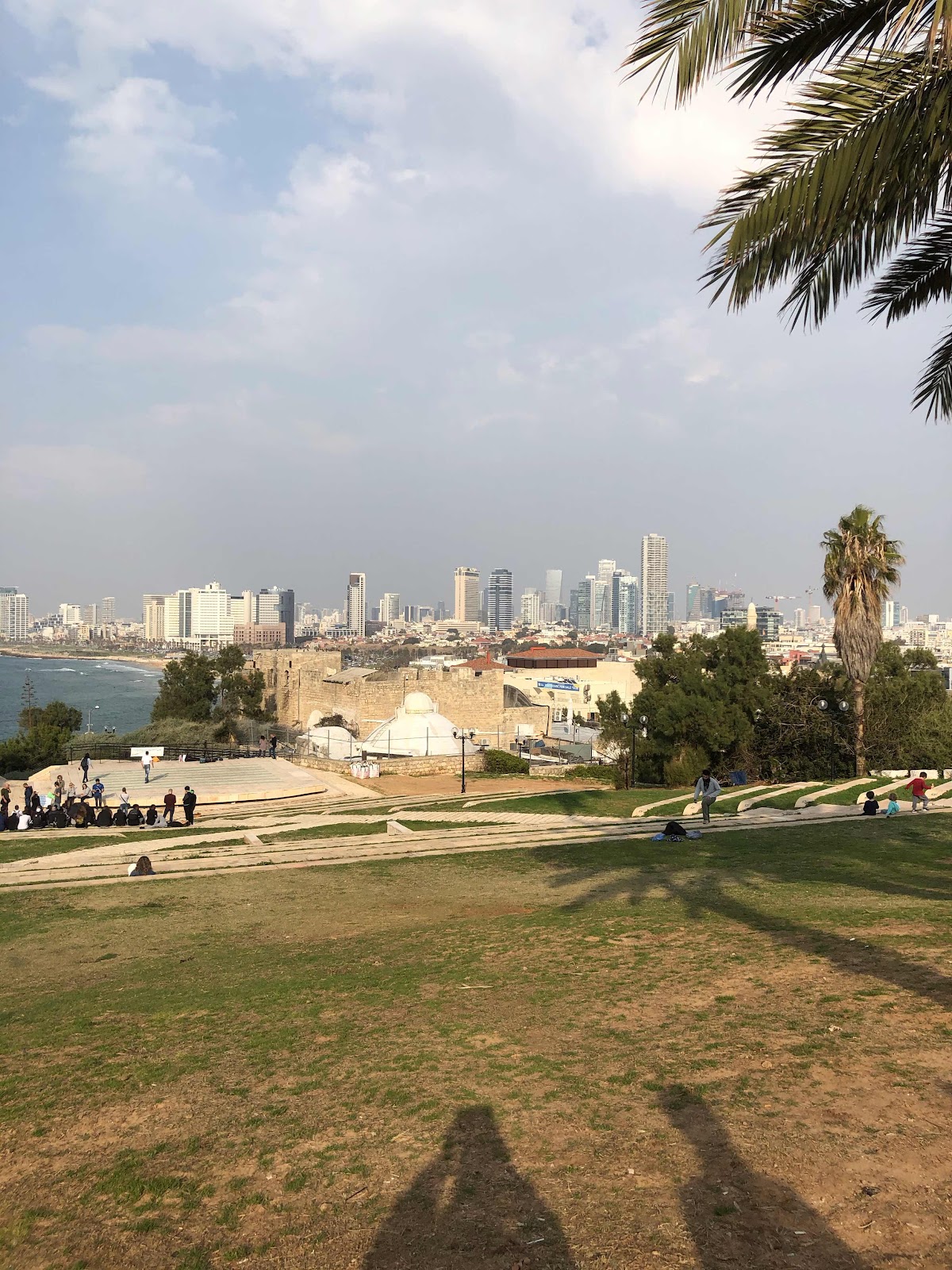
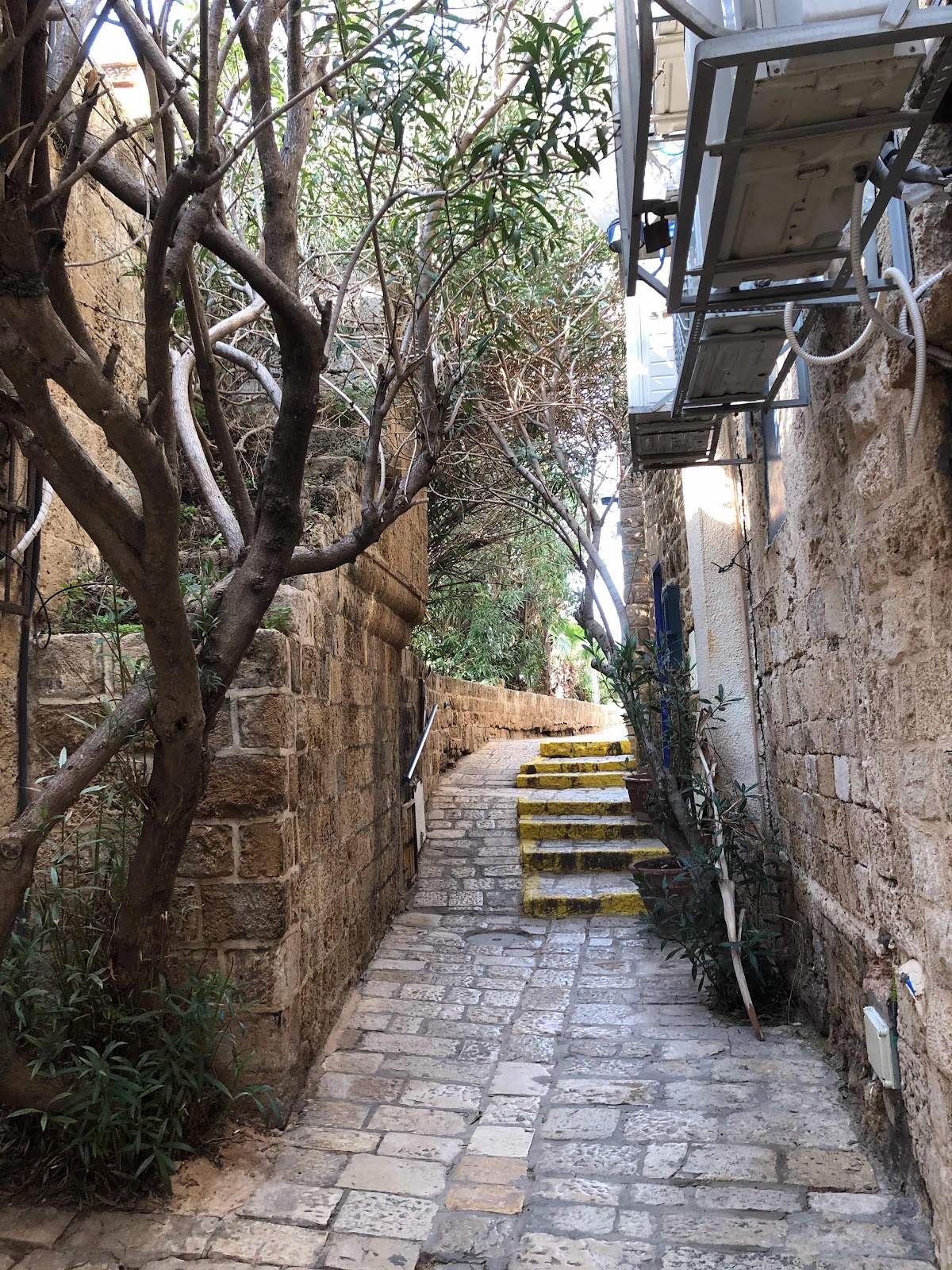
(View from Jaffa heights towards Tel Aviv beach)
(I get never enough of those views)
(cypresses on Mt Nebo site we visited with expansive views of Israel/Westbank)
I come, as they say in the Netherlands - the country of my birth - from “een goed nest” (a “home of good upbringing” is the closest I come to translate that). We (the children) had a strict principled father who ruled “his” household as a benign overlord and partook in public political life as he believed in serving God and Country, and a loving mother who saw that her role in life was: serving her husband and loving her children and in being who she was, trying to soften to friends and neighbors and to her children a potential range of negative images about her husband.
(Israel is lacking a lot of easy arable land, but it gives grand vistas in return)
As a first born there are expectations. Youth roles in the local church, as well as in society, hopefully using the stepping stones my father paved for me. I will never know if on the scale of expectations and realizations for him I ended up to be a small plus or a big minus.
(Tel Aviv open air markets string along across many streets)
Let me temporarily halt these musings in concluding that my religious upbringing resulted in who I am today, a Christian who lives in the knowledge that his place is awaiting him and although he does not have a clue what that really means, he believes, that he and the only wife that met my father’s and mother’s approval, Sandee will be welcomed together to whatever awaits us at the end of this life.
(Those colors kept mesmerizing me)
So with all that heavy unburdening in mind our seasoned traveling team, being the six of us (Linda, Gary, Marjolein, Herman and the two of us) arrived in Tel Aviv a few days ahead of the main group of predominantly Norfolk FPC (First Presbyterian Church) members, led by our minister Jim Wood.
As this is a pilgrimage story more than a travel blog, Sandee’s and my story of faith will shine throughout this blog in very different forms (I hope my dear Sandee to do you and your retrospective of this trip justice in the way I write this epistle)
(A sunset in the making in the Wadi Rum desert)

(the fantastic shapes of thousands of years of eroding desert)
It was in 2015 that we joined FPC, not because of my Presbyterian background (Sandee was raised Methodist and early in her adult life became a Quaker), but because after a few months of visiting different local churches trying to find a “home” for our spiritual side, pastor Jim Wood sealed the deal.
For Sandee FPC is a community that heavily concentrates on, as Sandee says it best, “good deeds”, being all the things a christian lifestyle can demonstrate in this world, like soup kitchen, jail ministries, offering overnight stays to the homeless in the winter times, raising funds to provide meals to the poor in our city, gathering our church family members for different projects like restoration work on homes in impoverished areas and painting in neighboring churches.
(the Souk in old Jerusalem)
Our own contributions concentrate predominantly on a children’s home and the scourge of HIV in the surrounding area of Nairobi, Kenya, as this mission has touched our hearts and we are able to easily combine it with our traveling lifestyle.
For me, Jim’s sermons, unlike so many others I suffered through, speak to me as he brings my responsibilities in life to the fore in ways I not often ponder.
(Walking the remnants of the Greco-Roman city of Jerash)
You see (and here I am going “heavy” again) we Protestants left the Catholic Church centuries ago because of diverging belief interpretations. The 5 pillars of our Protestant personal connection with God are based on a private relationship while seeking Him:
1. By faith alone, 2. By finding Him in the scripture alone, 3. By His Grace alone, 4. Through Christ alone, 5.Giving Glory to God alone.
(I had to find these “Solas/Alones” again to remind myself why Jim “spoke” to me, as he made me realize he would become in many ways a friend who would guide me back to those basics in my spiritual life, which I had abandoned over time in various ways)
(those beautiful colors of cavelike sights in Petra)

(Shadows on the walls while walking towards Petra’s Treasury)
So after reading all this, you would think: “Well the 2 of you are THE prototype of pilgrims.”
So here our travel blog starts:
First the bad and then the good.
(Despite my aversion to all those churches on top of holy places, there
are sights to behold in many of them)
Christian pilgrimages are a booming business in Israel, maybe even as much as Saudi Arabia profits from the Mecca goers. So if you visualize the iconic picture of that large open space filled with the 2 million annual hajj goers circling the Kaaba, realize that Israel receives about 3 million tourists each year, of which at least half of them are Christians booking pilgrimage tours to the holy sites, to which one can also add most of the other tourists, who visit most of the same sites such as the Wailing Wall in Jerusalem, Bethlehem and the Sea of Galilee.
(the mighty Jordan River is sometimes giving you a less mighty perspective)
Had I researched those numbers ahead of time, I would not have had my first disappointment:
Being herded from site A to site B, arriving in parking lots filled with dozens of buses all filled with Pilgrims wanting to see the same sites at the same time.
Disappointment 2: all those buses congregate during lunch in likewise large parking lots herding the masses to communal tables in convention-like halls, to be fed buffet style in 30-40 minutes before being herded back to the bus.
Disappointment 3: Roman and Orthodox Catholic Church denominations have claimed sovereignty of the religious sites, which celebrate one of Jesus’s many stages in life on earth as we find written about in the Bible, by firmly building a house of “their” worship on top of it and in doing so are “consecrating” their version of the celebration of the event, which pilgrims wish to re-experience in a physical setting. For me that “destroyed” and if I want to be nice “spoiled” the experience most of the time.
(One of those rare moments: Gary and Herman
have nothing to say to each other over lunch)
(souvenir shops are big business)
Note here, that above disappointments reflect my feelings. Sandee although sharing those feelings from an factual point of view found opportunity in deepening her faith experience like most of our travel companions, who come here to visualize their bible readings and teachings.
As you my readers know by now, the blogs I write are about pictures more than my musings, which are predominantly written as a homage to my spouse for her to re-read in future years. Most of you don’t know that there is a print edition of all my blogs (5 volumes and counting) with a published quantity of 1, gracing our bookshelf in Norfolk. And I for the life of me do not understand why she wishes to share these ramblings with all of you.
(This cart full of freshly baked bread is maneuvering thru the narrow alleys of the Souk)
So let’s start:ISRAEL (somewhere in China a corona virus is killing people in alarming numbers)
(Modern Tel Aviv near our B&B)
The six of us had a beautiful sunny day in, as named by Israelis: “unreligious” Tel Aviv, staying in an AirB&B near the beach and wandering from there south to the old district of Jaffa, a township that existed long before Tel Aviv was built, as an Arab fishing village. After 2 nights in sunny Tel Aviv, we relocated to the north meeting the US group in the town of Netanya (Israel’s prime minister’s name indicates he should hail from there.)
(Miriam’ Grill is our first Kosher Lunch in Netanya)
Our first destination was the Sea of Galilee, to which we traveled by a bus that could have accommodated twice the size of our group, led by a funny and very knowledgeable Israeli christian tour guide named Joseph (very appropriate name for a guide), who knew his bible better than most of us and was very good in linking the Bible stories to the physical locations we visited, sprinkling facts and fiction throughout the day. Somebody should have recorded the whole time he spoke.
(I have forgotten when the first arched roof constructions were used without mortar)
And here I need to digress again, so that you know that this blog will not be about this place and that place where Jesus did this and then that place where we were visualizing what Jesus etc etc etc .....
I include at the end the itinerary of this trip for those that want to know all these locations and visualize biblical representations of his roaming on earth 2000 years ago.
(Archeologists placed this beauty high up there to prevent touching)
The benefit of the two of us having the luxury of traveling the world is among others, the growing realization that we humans in our evolutionary tract from “ape” to “social media overload beings” were able to see not only the natural beauty this globe has to offer, but also visit many different cultures steeped in manifestations of different religions, Islam, Buddhism, Hinduism, Judaism, Shinto, Sikhism etc etc. And we saw the edifices of earlier religions in Egypt and Greece and Rome and many places in Asia. Not to speak about my earlier days in Africa where still many people practice some forms of indigenous religion, dealing with cosmology, traditional practices, symbols, gods and goddesses surrounding their tribal settings, as much as Incas and Inuits have done so over the centuries in which we humans have roamed this earth.
(My first of a few parking lots showing tourbusses)
Every human carries within him/her eschatology, those personal thoughts and concerns with death, final judgment, destiny of soul and humankind.
And this explains all those religions as they sprouted all over the world, in those early days in regional form, since people only roamed so far by foot or on animal, and now via the “microphone” of internet and television, with the added confusion of our growing knowledge of a universe and secular science.
(Did I say lack of arable land?. Well here is arable land, but don’t ask me what for)
So forgive me as this very different blog will not be about Jesus my savior, but about the country he roamed in his days, especially since I had a hard enough time to visualize those days and happenings being confronted with the “monstrosities” created by good meaning fellow Christians. My take away was that I experienced this voyage more as confirmation of the inner conflicts I have always had in my communications with my Jesus, in that like in the Gospel of John my upbringing, my spiritual relation with the God Jesus I know, brought me that happy feeling that I was privileged to walk where he once walked and to imagine how different the countryside must have looked in those days, and that I must refrain myself from judging how others experienced this trip, almost exchanging secret smiles with John (the one Jesus loved) as we watched all the circus like activities around us, knowing I behave badly by just thinking that.
(We did a lot of waiting in line)
So from hereon forward only pictures with explanations and no further ramblings.
Ceasarea Maritima
22 BC King Herod began building a harbor for his empire to compete with harbors like the Greek Piraeus and the Egyptian Alexandria.
He chose the worst of places: a city in those days called (in the english of today) Strato’s Tower, a city Emperor Augustine had recently given him for his loyalty to the Roman Emperor. This city on the Beach had no natural breakwater and was sandy without any rocky sea bottom base. He built a palace for himself, and of course as was the requirement of those days, a half moon arena or hippodrome for games and theater performances and called it Ceasarea Maritime. Within a year the harbor piers started to crack as sand under the construction washed away.
So the engineers imported from Sicily a Vesuvius volcanic ash to mix in with sand, lime and gravel to create a compound much like concrete in order to reinforce the sagging harbor. It became a very expensive reconstruction, to bring that miracle compound from Sicily in very large quantities, especially since right behind Ceasarea that compound could also be found in the Golan Heights.
(the reconstructed amphitheater in Ceasarea)
But there were no labs that could prove that the material from Golan Heights had the same elements. So since the Sicilian variant was a proven entity, it had to come from there.
It was from here that the apostle Paul started his journey to Rome to be facing the court of his peers, which he requested after his arrest as a troublemaker spreading the gospel of Jesus.
After getting back on the bus we proceeded that afternoon to Megiddo
(the Mediterranean Sea where once a harbor must have been)
(supposedly Herod’s Palace was here overlooking the Sea)
(Paul’s Journey to Rome started here)
Megiddo
Megiddo is today a dusty kibbutz in the Jezreel valley, but it has an illustrious history, located near a narrow pass on one of the ancient important trade routes linking Egypt with Mesopotamia and the rest of Asia Minor. Major battles took place in Megiddo: Joshua fought here f.e. and Solomon demanded forced labor from this town to build his temple and the word Armageddon means literally “the hill city of Megiddo. In WW1 the allied troops battled the Ottoman army at Megiddo.
(This aquaduct although not in use anymore is in remarkably good condition after a few thousand years)
Mt Carmel
We saw Megiddo from the viewing point of Mt Carmel, traditionally called the vineyard of God, but in actuality with its many caves in the hillside it was often a refuge for criminals in hiding. It is often also called Mt Elias, the place where allegedly the prophet Elijah defeated 450 Baal priests/prophets in a battle to light fire to an altar offering without the use of fire, an altar Elijah doused in umpteen gallons of water instead before having his God light it. One of the many fun stories in the Bible, with a gruesome ending for the Baal prophets.
(Excavations do not stop beautiful trees to claim their own territory)
(Prophet Elijah at Mt Carmel where he challenged 450 Baal Prophets)
(This supposedly is the altar site where Elijah offered is soaking wet
Bullock (steer) with fire from heaven)
Nazareth
(Nazareth wouldn’t be on the map without this large church “Basilica
of the Annunciation” and a few other competing churches)
Nazareth is nowadays one of the larger cities in Israel with about 75000 citizens whereas in Jesus’ time it supposedly had about 500 citizens, who all knew each other fairly well, making Mary most likely a subject of conversation to be seen pregnant and unmarried. Joseph must have been a good guy in keeping his promise to marry her anyway, as I so well know from my past.
Well you all know the story of having to travel to Bethlehem to be counted as per the law issued by Emperor Ceasar Augustus. Joseph and Maria returned to Nazareth after a long stay in Egypt to remain out of the hands of Herod the king, who would have loved to kill them, when Jezus supposedly was about 4 years old.
In Bethlehem, which we visited later, a massive basilica, Church of the Nativity now covers the Grotto of the Nativity, where supposedly Christ was born. Emperor Constantine already in 326AD ordered the construction of a Basilica over the Grotto. I will spare you my reader the stories about the multitudes of destruction and rebuilding of the various churches and basilicas on that spot.
(the Christ Anglican Church in Nazareth we visited)
(the walls were filled with gifted art from all over the world)
(I am minimizing the number of pictures of churches and the interiors we saw)
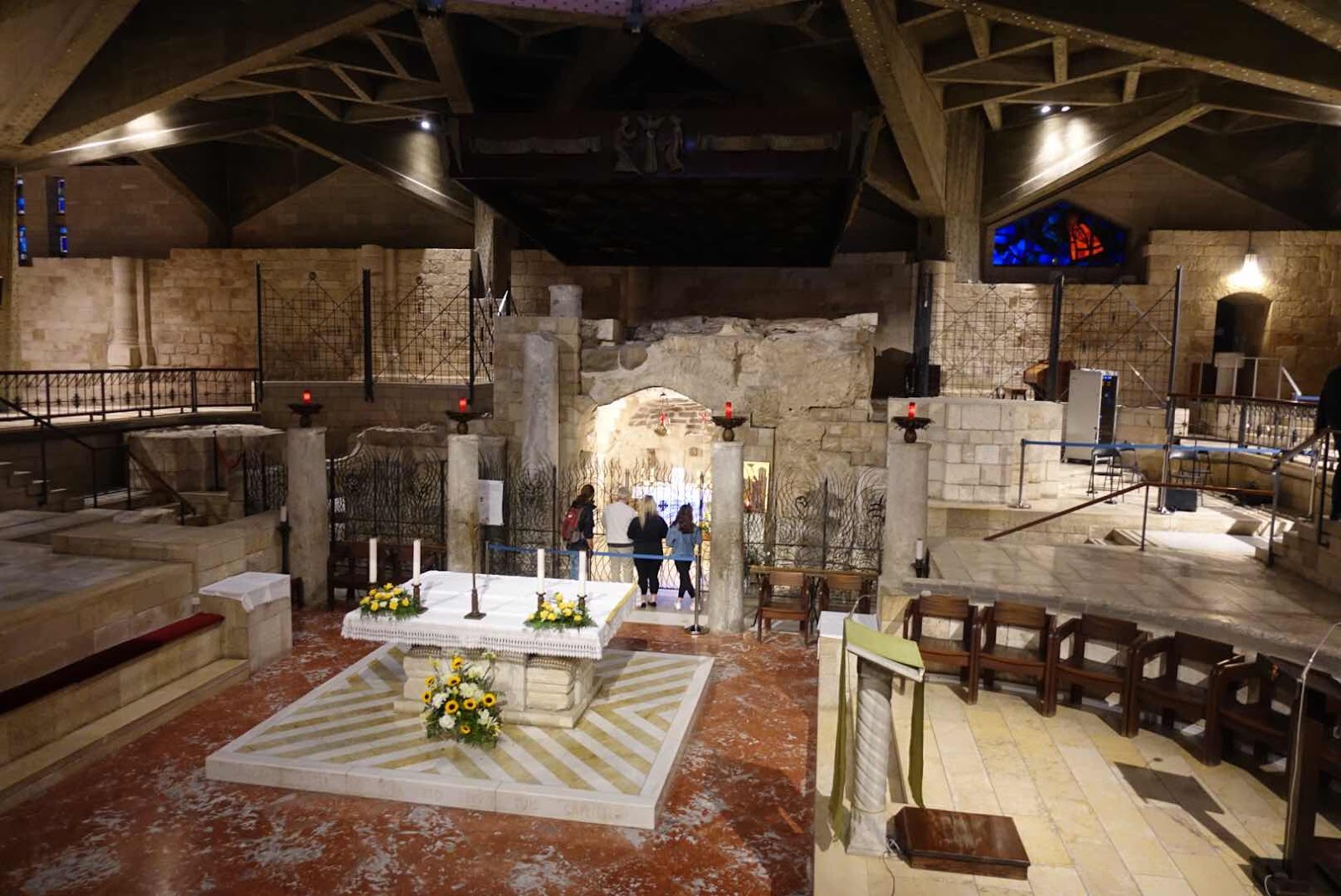
(the size of these churches in a country with few Christians
tells you that they are here for the pilgrims)
Tiberias and the Sea of Galilee
The Sea of Galilee receives its own water from the Golan Heights and from underground springs as well as the Jordan River passing through it and is often also called Lake Tiberias. The lake most likely is the result of the friction between the African and Arabian tectonic plates. Earthquakes are not uncommon in that part of Israel. The lake is at constant danger to become the next Dead Sea as saline levels increase. The Israeli government has formulated a plan to create a tunnel from the Mediterranean Sea to pump desalinated water into the lake. Tourism here is for the largest part depending on Christians wanting to relive at the lake the manifold of miracles with Capernaum on its shores as a main destination.
(Tiberias Dock in the early morning light from our hotel room, from where
Pilgrims take tours to experience the Sea of Galilee as it was in Jesus Times)

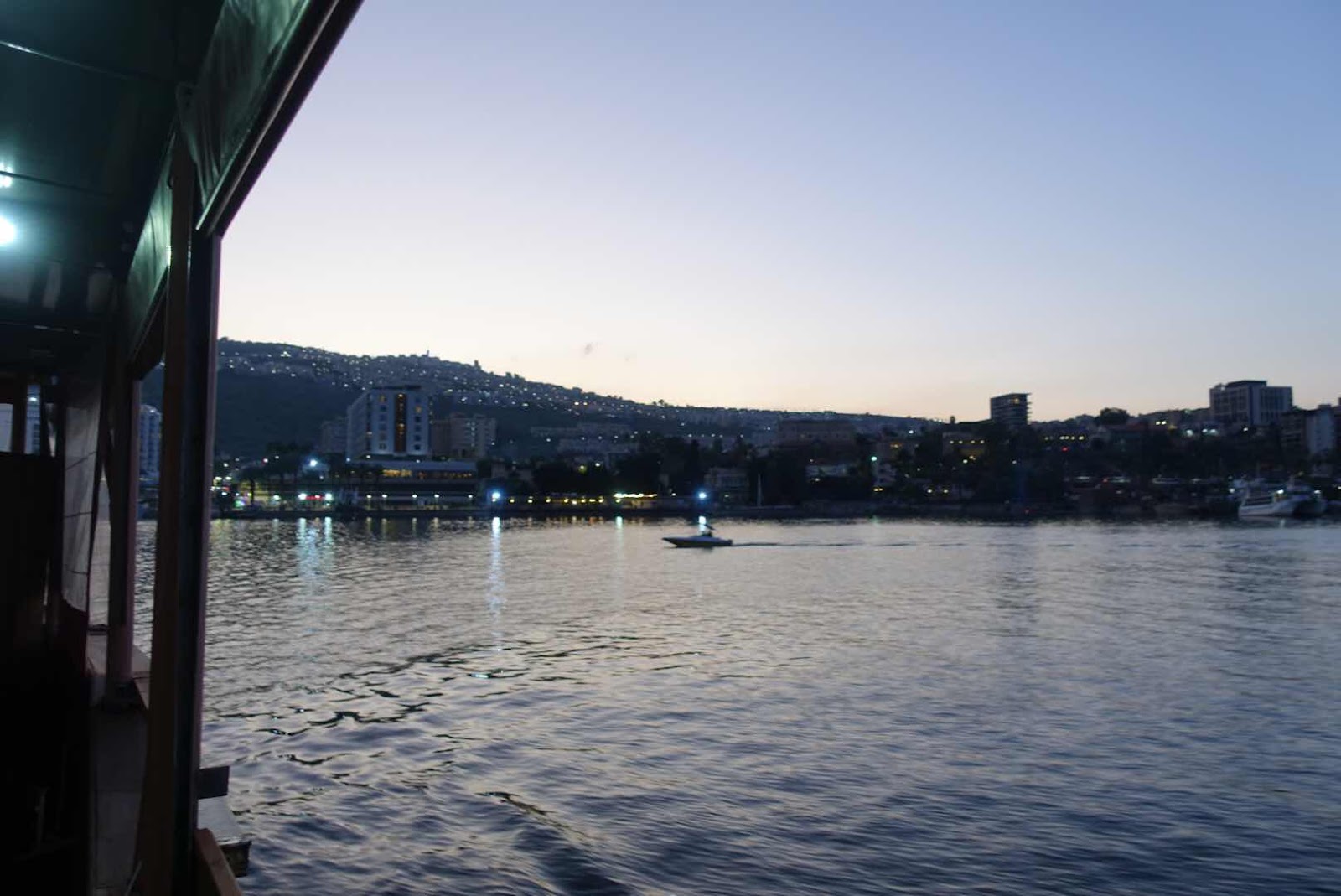
(The raising of the American
Flag ceremony)
(A view from the boat towards the shore in the dimming evening light)
Bethsaida and the Mount of Beatitudes and the niche of the god Pan at Banyas
As one drives around the Sea of Galilee up north towards the border with Syria and Lebanon but still firmly within Israel as the Golan Heights are solidly under Israeli control, one cannot but marvel about the size of this lake and imagine how turbulent the waters can be on stormy days.
(Banyas archeological park with a view at the parking lot as I do more often in next pictures)
(Sheer cliffs house caves and remnants of ancient buildings where the God Pan
once was prayed and offered to)
 (Above and below pictures show the remnants of what once was a thriving city called Ceasarea Philippi)
(Above and below pictures show the remnants of what once was a thriving city called Ceasarea Philippi)
Tabgha
Tabgha, a city at the northwest shore of the Sea of Galilee has had chapels and a monastery as well as presently the Church of the Multiplication. So a lot to visit in a small town, all because of what happened here. Below the Church courtyard.
(Olive trees are sometimes older that the surrounding buildings
like in this courtyard it is the center of attention)
(The mosaic floors were still in perfect shape after so many centuries)
On this location Jesus fed the thousands with just a few loaves and fish, one of the most known miracles in the Bible as he preached on the nearby hill: “the Mountain of the Beatitudes”. A 5th century mosaic was to me especially impressive. The church here is owned and maintained through Benedictine monks under the supervision of (you would never guess) the Bishop of Cologne, Germany. However at the lakeside is a small church named the Primacy of St Peter, celebrating the fact that Jesus, appearing for the fourth time after his insurrection conferred again on this spot he primacy on Simon Peter.
(Primacy of St Peter Chapel on the lake)
(The chapel has beautiful windows)
(Archeologists are still at work in the chapel)

( And of course the parking lot is filled with buses,
even at the early morning time of our visit)
Capernaum
A few minutes away from Tabgha lies Capernaum in Jesus time a thriving fishing village and home to apostle Peter and tax collector Matthew, which is close to Bethsaida the home town of Simon Peter and Andrew, James and John. Capernaum is such a big part of the pilgrimage tours, because Jesus started his public ministry here and spent a considerable time here. Many miracles were recorded as happening in this part of his time on earth.
He also cursed these towns in the gospel of Matthew because of people’s lack of faith in him, by stating “you will be thrown down to Hades”.
(Outside the real town you find the archeological park of Capernaum)
(The only “new” building here is of course a church,
which I do not show in this blog)
(And it is definitely not certain whether the town looked like this in Jesus times)
(Statue of St. Peter, 12 foot tall and a fish at his feet
and the key to heaven in his hand)
(the Church has placed these kind of tablets in many languages
on its grounds. The interesting element is here that it is paid for by the
UN high commissioner for refugees with the following text:
“ This stone is placed in gratitude for all the countries that followed
the BEATITUDES by rescuing hundreds of thousands of Vietnamese
Refugees on the Pacific Ocean after April 30, 1975 as they escaped
from the communists”)

(celebrating 800 years since St Francis
pilgrimage to the Holy Land)
(walking down towards the Sea of Galilee as we hoped to see the meadow
where Jesus preached to the Multitude, only to find a sandy road past
-see below- banana plants)
(I couldn’t get enough of those mosaic floors, so perfect after so many
Centuries)

(Just a picture that gave me pause: a quiet corner)
Jacob’s WellTraveling down from the Sea of Galilee to the Palestinian city of Nablus one will find under a massive church and down in a cellar Jacob’s Well where according to Genesis Jacob returned to the promised land and pitched his tent (another way of saying “bought the land”). The question is whether the well was there or whether he dug the well after he settled there. From a pilgrims point of view the visit relates to the story of Jesus asking a Samaritan woman supposedly near this well for water as he rested from a tiresome trip. In those days that was a faux pas of enormous proportions. But it is not up to me to give a sermon here about the how and why of Jews talking to Samaritans
(We arrive with our tour during a sermon and almost have to pass through the gathered to
make our way down to the well in the cellar)
(Clearly an old well being well preserved)
(Tourist women bringing up water. I will hold my tongue
and not comment on the thought I had with this re-enactment)
(the courtyard outside this church in Nablus was serene and peaceful)
(A typical example of a Palestinian town above as well as below)
(As we travel by bus through Palestine - the West Bank, beauty is not to be found)
(the side road that forks off from our highway leads to an area with below sign)
Monastery of Saints John and George of Choziba
A large monastery high onto a clifflike barren wadi was lastly inhabited by Father Germanos, a Greek Orthodox monk, who lived there from 1993 till 2001when he was killed during the Second Intifada by Arab terrorists. Tradition suggest that the prophet Elijah was hiding here and fed by ravens. Since it’s rebuilding in about 1100AD hermits have lived here on and off.

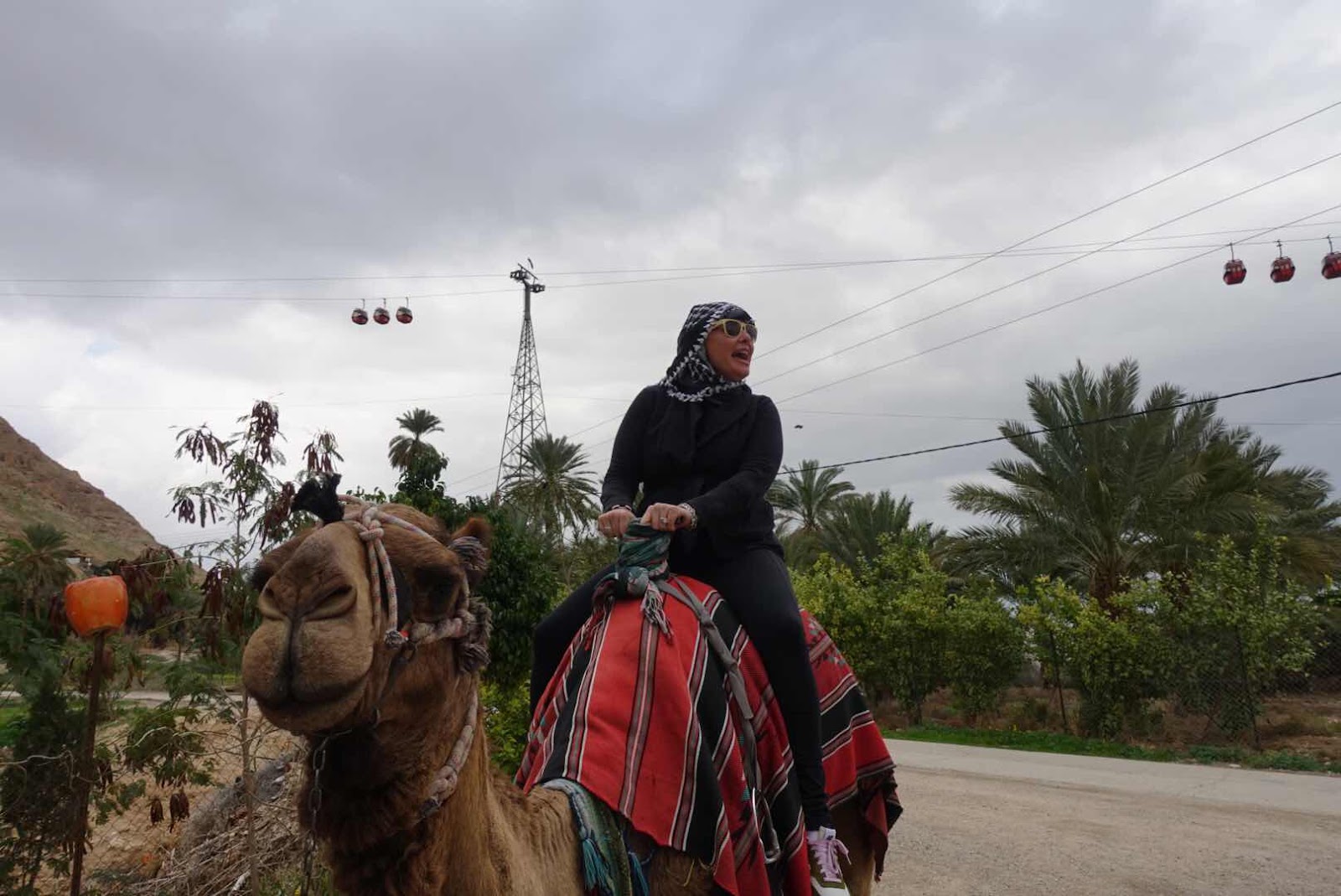
Jordan River Jesus Baptism by John the Baptist
(this monastery empty and high up the mountain cliff was mesmerizingly beautiful to me)
(a tourist stop gave some of us the chance to sit on a camel)
Jordan River Jesus Baptism by John the Baptist
An unimposing site on the Jordan River where supposedly John the Baptist was known to baptize many people and among him also Jezus. Nowadays many a pilgrim uses this spot to wade into the River to be baptized again. According to lore as this was a common spot to wade across the Jordan, the Israelites crossed here into the promised land and this seemed to also be the place where the prophet Elijah ascended to heaven. I chose, out of respect, not to take pictures of the re-baptism ceremonies in the waters of the River Jordan here.
(above and below pictures show a drab place and an unassuming River Jordan)
Dead Sea
The Dead Sea may be dead in a few decennia as it recedes its water levels with about 3ft/1m per year. It is already about 1400ft/425m below sea level one of the lowest if not the lowest point of dry land on earth, with a salt concentration of 32% or 9 times saltier than ocean water, and lethal to ingest. But floating on the water was fun and the main reason for people to come to the hotels here bordering the Sea, touting spa treatments and selling Dead Sea salts in many forms.

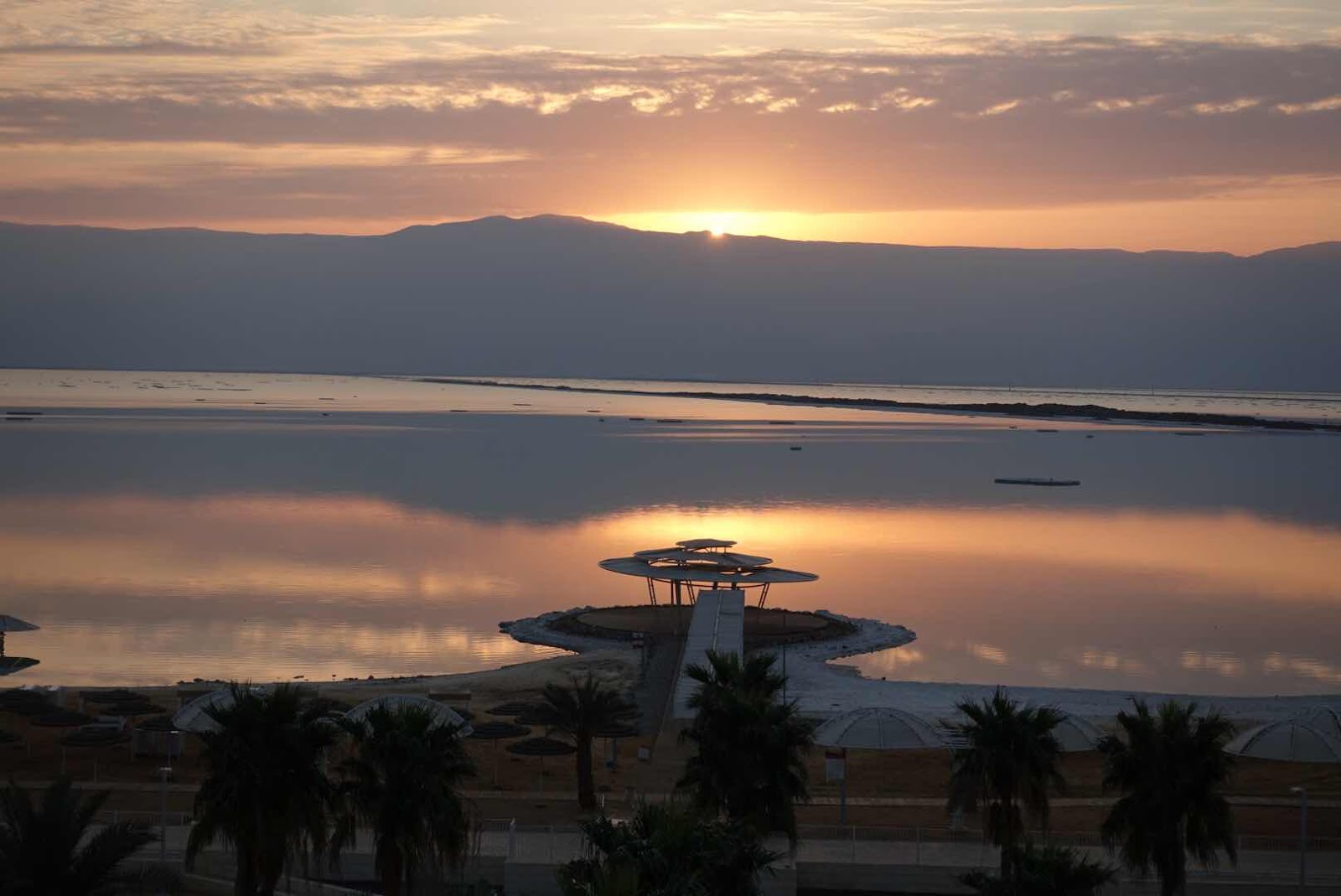 (a few more)
(a few more)
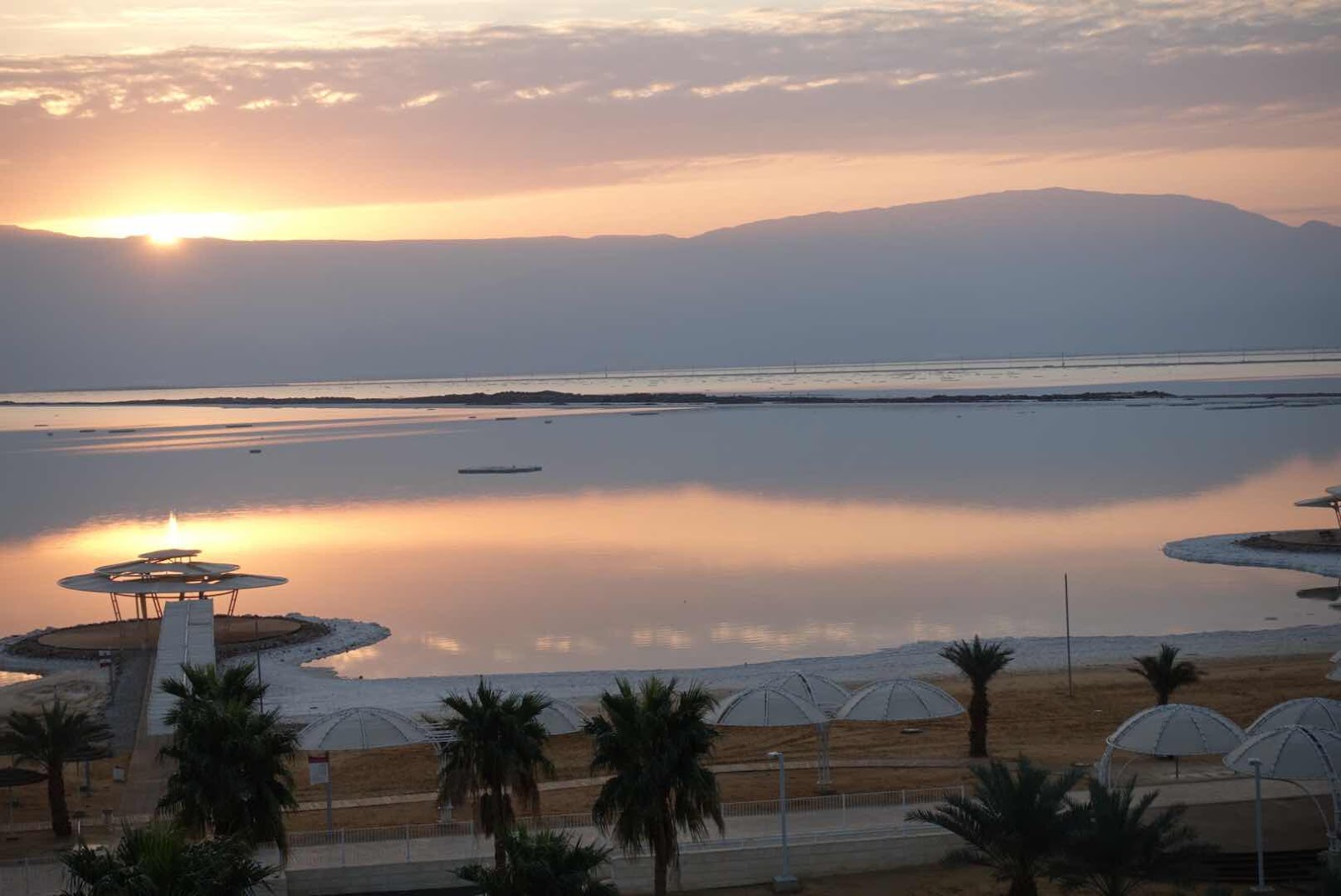
(views from our hotel room over the Dead Sea )
Masada National Park
Also overlooking the Dead Sea, we visit the next day on our way to Jerusalem the Masada National Park, a fortress on top of an isolated rock plateau, difficult to climb, reason why about 35 years before the birth of Christ, Herod the Great had there a fortress with Palaces built, to assure a safe refuge for himself and his family in case he had to face an uprising or invaders. He knew that he was not beloved by his people. We took the cable car to reach the top.
(entrance to the park)
Masada is famous and a definite tourist attraction for anybody visiting the Dead Sea, for the lore of the Siege of Masada by Roman troops in 73AD as that army was wrapping up the last remnants of resistance to end the first Jewish Roman war (yes there were more, but that is an entire different story). On the 400 meter (1300ft) high bluff according to the history books as written by romans were about a 1000 Jewish rebels (men, women and children) holding out. It took 15000 attackers about 2 to 3 months of siege to eventually creating an assault ramp and a battery ram to breach the defense walls that Herod built long before to conquer the bluff, finding supposedly mass suicides ongoing.
Since the 1960’s archeologists have uncovered the ruins of Herod’s palaces and fortifications, which Israel at great expense has restored.
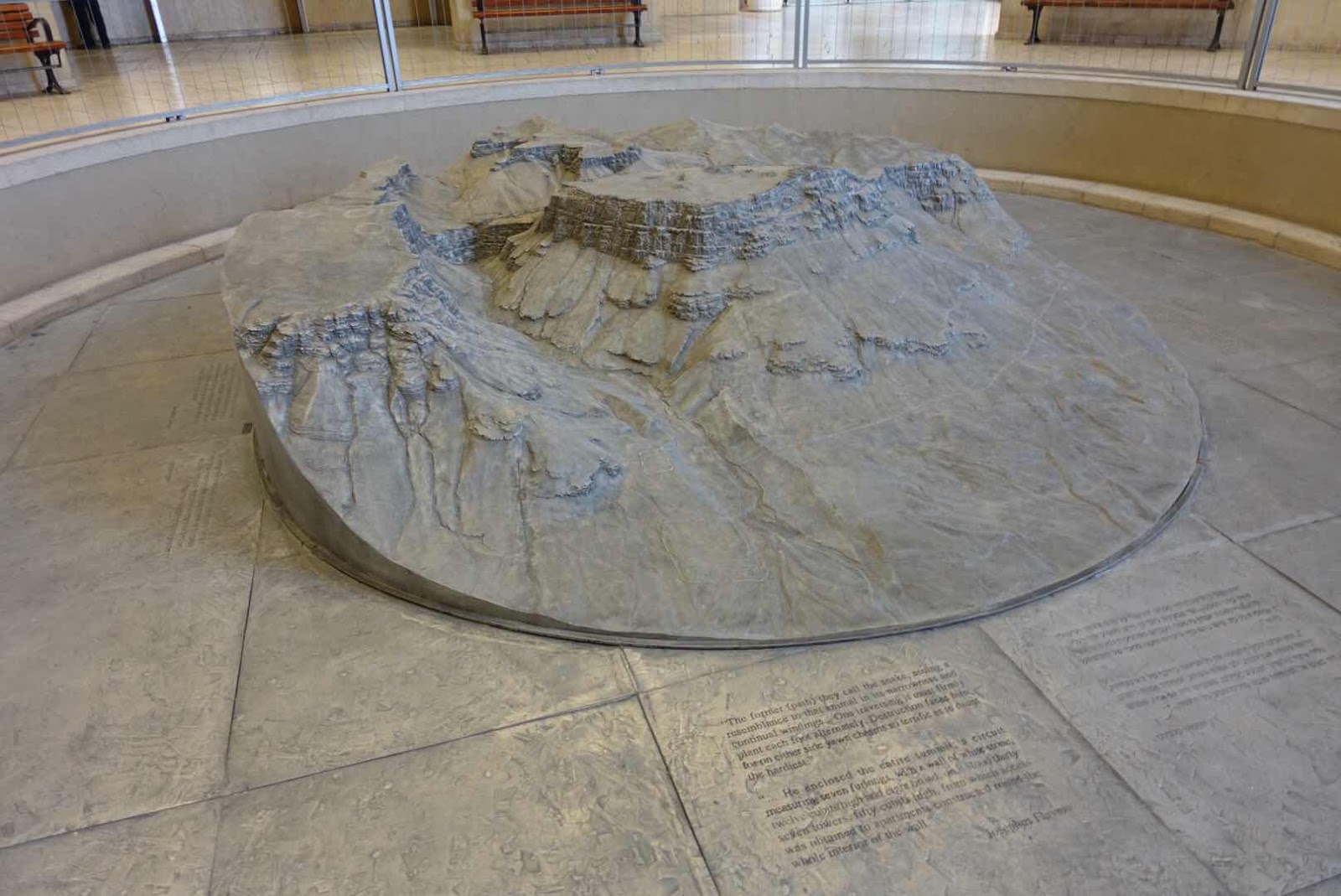

(the cable station below give the best view of the Rock)
(in the visitor center at the bottom one finds a model of Masada)
(the cable station below give the best view of the Rock)
(arriving upstairs we view the surroundings as does this black bird that has found his habitat here)
(Tablets describe the buildings that once were here)
(A selfie with the help of a stranger shows the plateau in the background)
In 1947 a Bedouin goat herder went into a cave he had never visited yet to discover the famous Dead Sea scrolls and later excavations in that area uncovered about 900 of them with writings on papyrus or parchment and even leather. There are tales that he used some of it to make shoes for himself. But scientists reject that notion, as the material is to brittle for that purpose. He tried to sell his finds without much success as they were labeled forgeries, until a few years later archeologists became interested when other Bedouin’s found more caves with content. The present story is that in the century before and after Christ a strict Jewish movement “The Essenes” settled in the Qumran area and created a library of their documented views outlining their conflicting opinions with mainstream Jews and especially with the Pharisees of those days. The Essenes believed they were living in a time where God would soon establish a kingdom of peace.
(the cave hole on this picture could have contained scrolls)
(a pitstop allowed everyone off the bus to walk to the edge of a bluff )
Bethlehem.
I think the least interesting part of the trip was Bethlehem an overrated place to visit with big overtones of commercialism. With a massive church built over a possible birthplace of Jesus in a dirty Palestinian city, that has nothing to shown for, than that it’s very name “Bethlehem” makes it famous.
(Don’t know why I took this parking lot picture across from below Bethlehem Souvenir Center, where the group wandered among, in my opinion, horrible stuff for a long long time, allowing me to walk out in disgust and shoot pictures outside )
(should I say more?)
( what I found however a hundred yards from the store is this wall)
(interesting isn’t it?)
(and right beside above poster on the corner this sign)
(and turning a 180* a view of the city center)
(the later visit to the church of the Nativity with the grotto below where Jesus supposedly was born)
(talking about large churches on top of assumed locations
above as well as below)
(the courtyard in the back of the church brought some serenity to me)
Jerusalem
Jerusalem is a city which name has a ring to it, a city that without a pilgrimage is worth a visit in its own right. A clearly middle eastern capital, that like other major middle eastern towns displays a charm of present beauty as well as historical significance, which its displays well within its ancient center. From a distance, as it undulates over its seven hills it does not seem impressive, just very large and widespread. Now as a matter of trivia, there are reportedly more than 19 cities in the United States claiming the title “on Seven Hills”. Moreover the most famous one claiming that title is Rome , but also Moscow, Tehran, Lisbon, Amman and historically Babylon, all want to be known as the city on Seven Hills.
(a first view of the city at an overlook)
(thousands of cemetery crypts at the edge of town sloping down a hillside)
(a view of the golden turrets of the Russian Orthodox Church
outside the walls of the city just below the cemetery)
(how old is this olive tree? Well scientists say that in Bethlehem the Al Badawi Olive
tree is between 4000 and 5000 year old. This one very looks old too)
(entering the old city of Jerusalem)
(a first look at the wailing wall or western wall of the original Temple Mount location)
(on the Temple Mount one finds a gigantic Building The Dome of the Rock, although not a mosque , it is one of the holiest places in Islam, a place where Mohammed supposedly ascended to heaven from)
(it was a rainy day with few tourists giving us an almost forlorn view of
the Temple Mount)


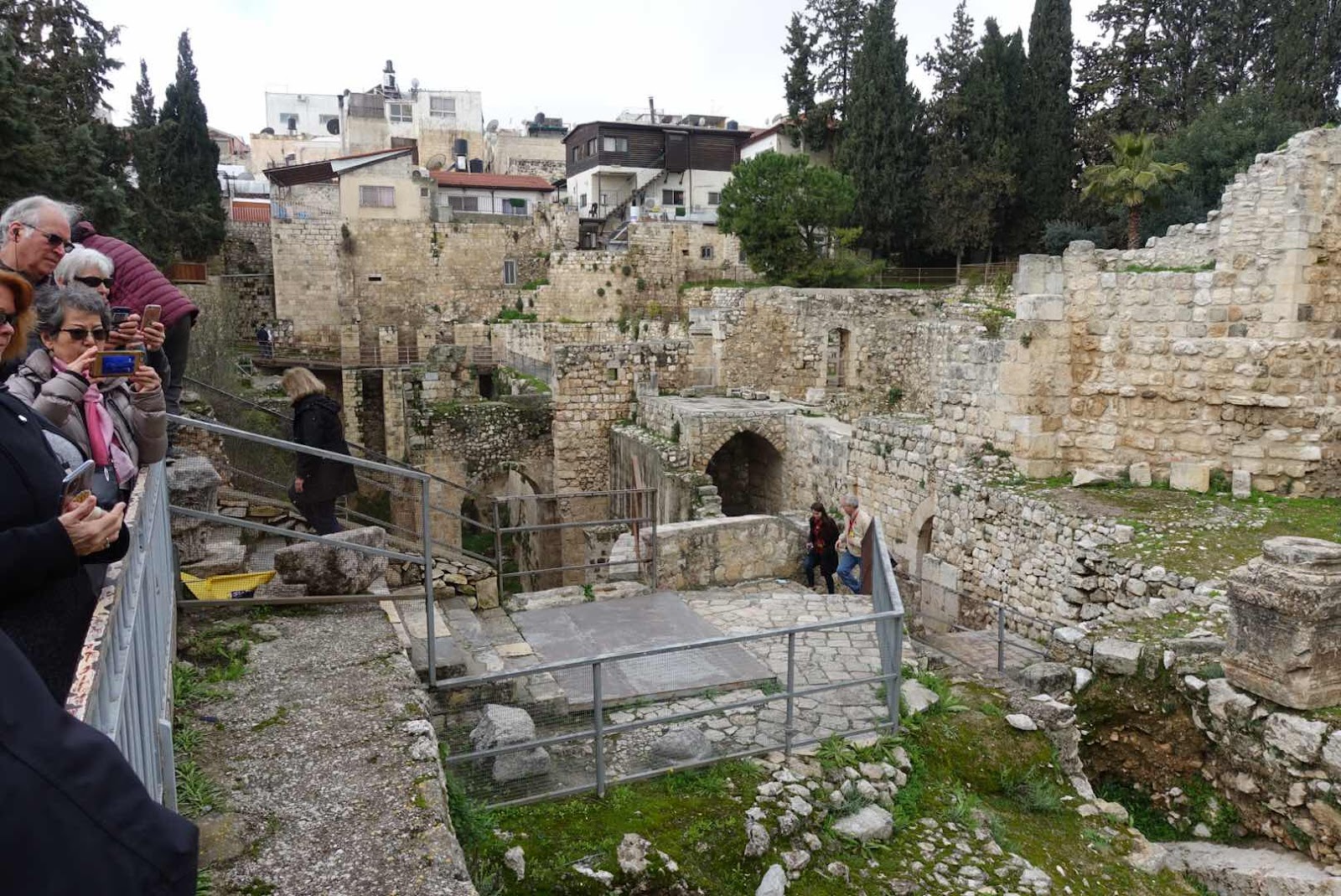
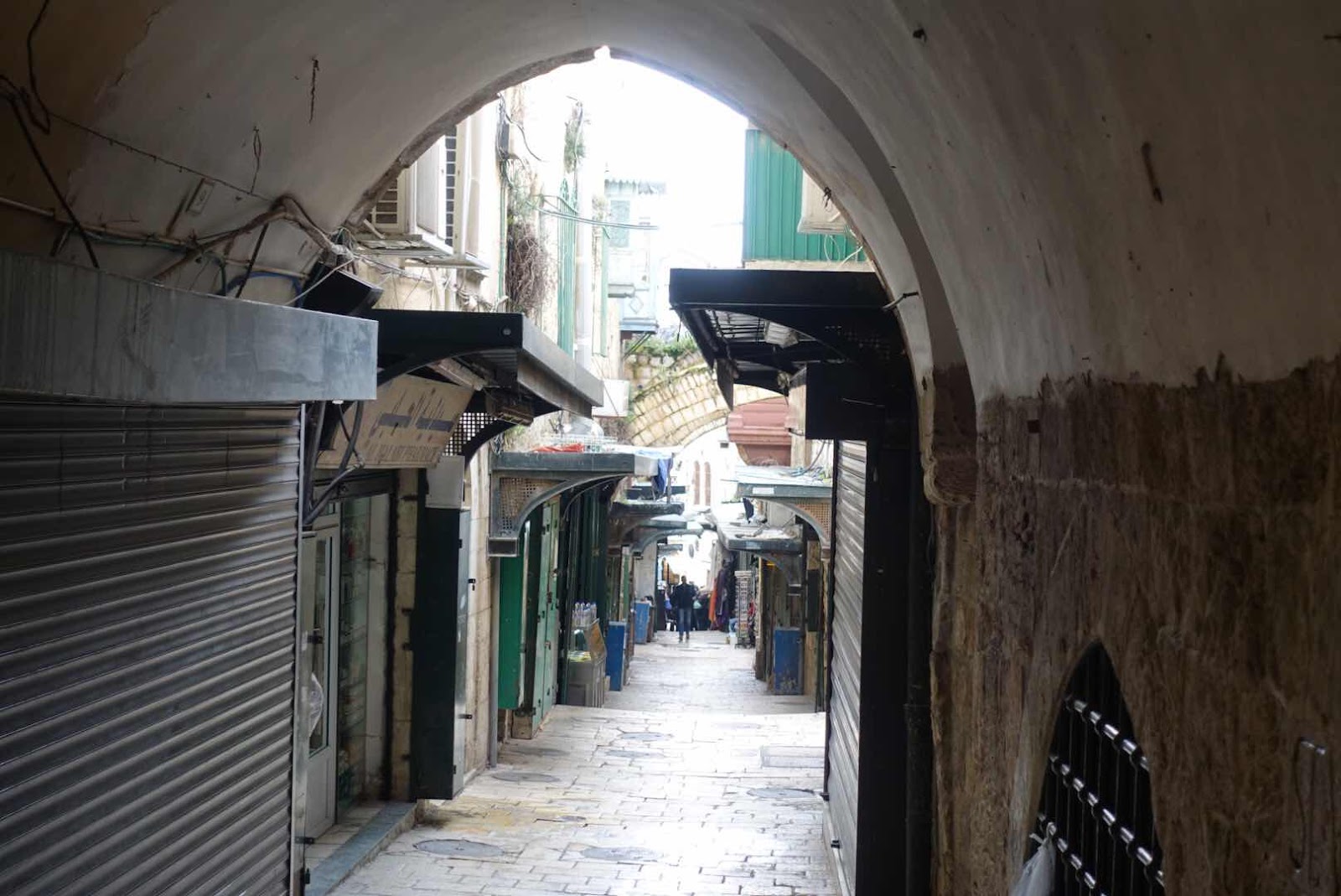
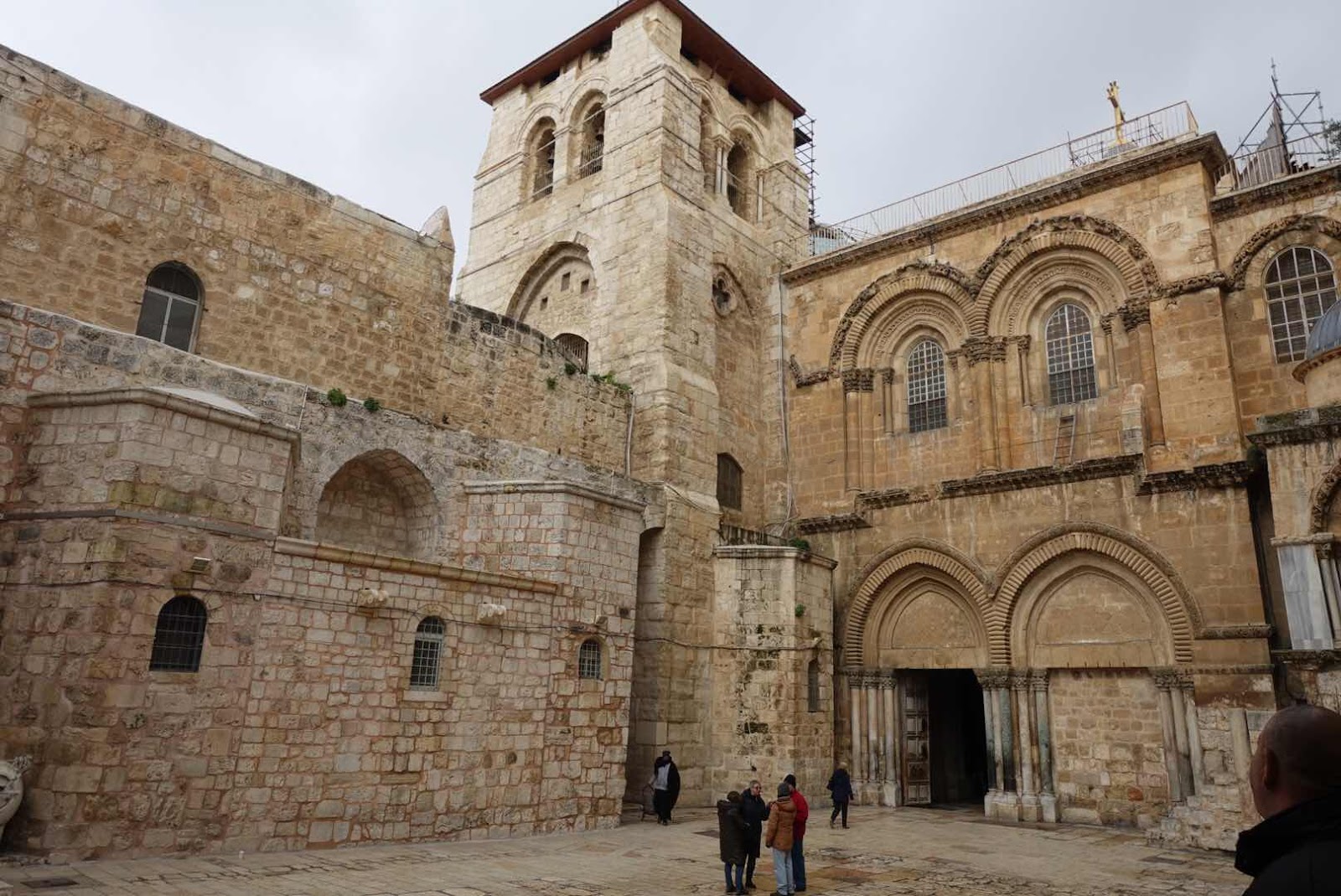
(the next adventure is walking the tunnels under the Temple Mount)
(It was interesting to see a maquette of the walled city of Jerusalem in brick)
(excavations are an ongoing business in jerusalem)
(a shot of an almost empty souk alley on our way to the Via Dolorosa)
(the entrance to the church of the Holy Sepulchre with inside the stages 10 to 14,
describing his crucifixion, his death and the burial sites. For me the story lost a lot of its historic veracity
right here in this ornate Greek Orthodox Church , covering the area where all these stages of his crucifixion and death and resurrection supposedly occurred)
(altar of the crucifixion at the spot he was crucified?????)
(there is a lot of “touching places”going on here)
(the atmosphere is subdued and at the same time too ostentatious)
(walking the Via Dolorosa brings you past these signs , this being stage 3)
(what touched me more was the Wailing Wall, as it is a present day experience
daily performed by Jews from around the world)
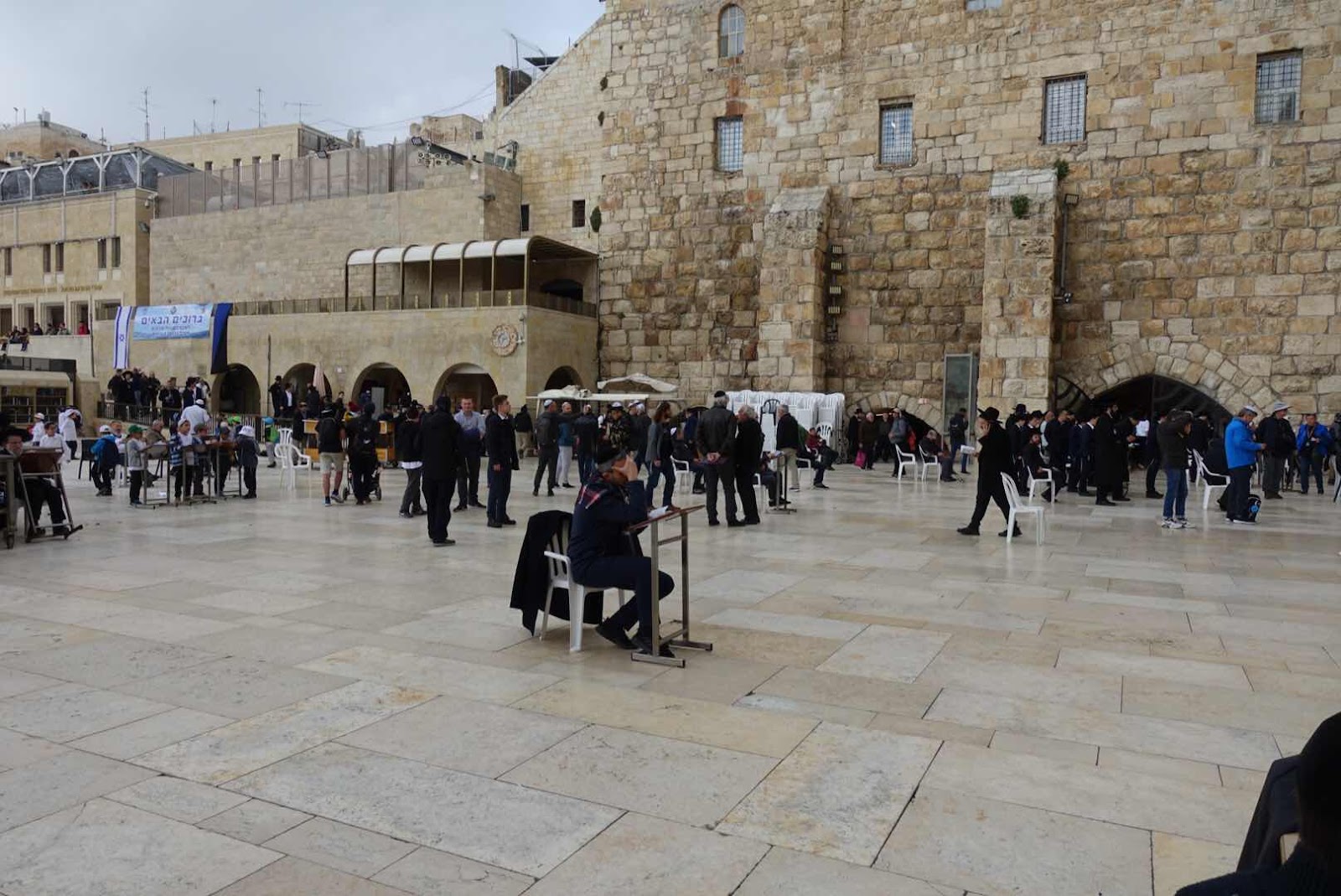

(the women’s section was less than half as wide as the one for men. Here are
(it is a place for reflection)
(the women’s section was less than half as wide as the one for men. Here are
boys placing written notes of prayer in the wall ‘s crevices)
(So I took a chair and sat there for about half an hour ,taking in as much of it as I could )
(our last stop of the day was visiting a burial site where possibly Jesus
could been placed after being taken off the cross)
Jordan
A much smaller group of us continued to visit Jordan for a few days. The itinerary is below, as is the one of the Israel journey.
A bus took us to the King Hussein/Allenby Bridge crossing, to undergo a process that is an experience in itself, since the immigration services of each country do not share facilities. Just like in the olden days, when I had to cross from West Germany into East Germany, one had to travel about a mile through no-ones land. A bus service takes border crossing clients, that have been processed at the Israeli site, to the Jordan processing facility and coming back the process is vice versa.
We made an error here, as our group was processed not to come back here but to leave by air from Amman airport, which was the tour organization’s official plan. However out little band, Herman and Marjolein, Gary and Linda as well as Erik and Sandee had arrived earlier from Amsterdam into Israel and were planning to leave later from Israel again. Our Jordan guide had quite some phone calls to make to correct our official papers in order to let us back into Israel.
The other interesting detail was, that for the first time we experienced the COVID crisis as it started to spread all over the world, because we were welcomed on the Jordanian immigration site by a person standing at the bus exit door with a thermometer taking each passengers temp before letting them into the building.
Only after having been processed and after having been able to find our luggage again from which we were separated in Israel, we found and were welcomed by our Jordan guide, whose name I have forgotten.
Our first destination is the famous Wadi Rum desert, made famous f.e. by British officer and writer T.E. Lawrence, nicknamed Lawrence of Arabia, who wrote The Seven Pillars of Wisdom around 1920, in which de described this “Valley of Airborne Sand” as follows: “The hills on the right grew taller and sharper, a fair counterpart of the other side which straightened itself to one massive rampart of redness”. I could not have said it better.
(but first you have to get there in a 2 -3 hour ride
passing this type of rock formations)
(and this type of barren land, which covers most of Jordan)
(To reach our destination, a luxurious camp site
with nice white airconditioned iglo like structures)
(the welcome center and dining room area)
(individual domes with bed room, sitting area and en-suite facilities)
(Our tour through the Wadi in the late afternoon and a bit later a setting sun)
(Sun and erosion will over the next centuries flatten the landscape and these
rock formations will gradually disappear)
(UNESCO put these 12000 year old petroglyphs on their World Heritage List)
(This iconic view is getting rarer in the Arab world)
(carving of the face of Lawrence of Arabia)
(on the way back up towards Petra the landscape changed to barren rocky countryside again)
(remnant of ancient cities near Petra)
(a 1km/2/3M walk through a meandering Siq (shaft), with 8 meter/26ft
high walls is the access road to the city of Petra)
(when you reach the end the “Treasury” building appears)
(the city of Petra dates from 312BC as the capital of the Nabateans
and the Treasury is one of the New Seven Wonders of the world)
(Nature’s composition that humans cannot dream up)
(the remnants of the amphitheater here in Petra)
(tourists mulling around in Petra, where not many restrictions
exist for them to climb these rocks)
(at the entrance of Jerash the original flatbread/pizza provider)
Jerash
Since the Bronze Age (3200BC -1200BC), this walled Greco-Roman city with origins as old as 7500BC has been a major metropolis from before even Alexander the Great, who supposedly was here for awhile after defeating Egypt and having his sights on Mesopotamia after that. It is known as one of the largest and well preserved Roman sites outside of Italy, reaching a size of 800,000 sq meters/200,000 acres. It is ironic that despite’s many invading armies, who held this city an earthquake in 749AD made it what it looks now.
(“Main Street” in the days of glory)
(One of the better preserved buildings on Cardo Maximus or Main Street)
(excavations are ongoing, with in the background the present city of Jerash)
(This building had a different building style, maybe much later?)
Mt Nebo
This is the claimed spot where Moses saw the Promised Land, and still today one has great expansive views of Israel from here. Already in the 4th century a church was built here and beautiful mosaic floors can be found in the present structure here managed by the Franciscan Order. Although never found, there are two places claiming Moses burial place and this is one of the contenders)
(Mosaic floor in Diakonikon Baptistery)
(the text under the staff of Moses with the brazen serpent)
(Italian artist Giovanni Fantoni created this bronze serpent)
(sign at the entrance of the park)
(Back in Tel Aviv we visited one more time the market area
and finding these gigantic deep red paprika towers)
(Netanyahu is present everywhere in Israel, even in the market alleys)
So at the end of this saga you found out that despite my promises halfway this epistle I rambled again since I just cannot stop myself. Not sorry.
And here as promised the official itinerary which I did not follow chronologically:
(Copy of the tour brochure we received long before our trip)
Followed by a description of the added trip to Jordan that we took
4 NIGHT OPTIONAL JORDAN EXTENSION
DAY 09 – WED. FEB. 26 – FAREWELL DINNER / LAST OVERNIGHT JERUSALEM
After our farewell dinner with the group, the folks who are ending their tour head out to the airport while we remain in Jerusalem for one more night.
DAY 10 – THU. FEB. 27 - JERUSALEM / WADI RUM
Following breakfast we depart Jerusalem and enter Jordan by way of Allenby Bridge. After completing border formalities we’ll meet our Jordanian guide and board our Jordanian vehicle to cross into the Kingdom of Jordan. We’ll travel southward as we make our way to our camp in Wadi Rum. We’ll enjoy a two-hour desert jeep tour, dinner and overnight under the desert stars.
DAY 11 – FRI. FEB. 28 – WADI RUM / PETRA
Following breakfast our journey continues to the ancient red rock city of Petra, skillfully carved out of the sandstone mountains. The city was cut from solid rose-colored rock. It was built by the Nabateans and Edomites, long before Christ and is thought by some to be one of the Cities of Refuge for Jewish believers during the Tribulation. We will walk through the siq for 1250 meters till we reach the 1st monument, The Treasury. While walking through we will see the water system; idols carved on the siq walls; and the paved road from the Roman period. The Treasury is the most fascinating monument in Petra as it has art decorations from the Hellenistic, Greek and Nabatean periods. Then it’s on to the Nabatean Theater, which accommodated 7,000 people. The theater is carved in the mountain of the high place of sacrifice, which suggests that the theater was used for rituals and not just plays. Further down we get to the most fascinating tombs of Urn-Silk-Corinthian and the Palace tombs. A walk up the stairs brings us to the urn tomb, which was turned into a church in the middle of the 5th century AD. We proceed downhill and come to the Roman remains of a cardo-Nymphaeum. An evening spent next to Petra gives us the opportunity to watch the sun set and rise over this magnificent city, dating back to the 4th century BC.
DAY 12 – SAT. FEB. 29 – PETRA / JERASH / AMMAN
Today we depart Petra and travel through the Decapolis region to Jerash. We visit one of the most complete and best- preserved Roman cities in the world. We’ll see colonnaded streets, the south theatre, and many Byzantine churches with beautiful mosaics. Further south is Amman, where we’ll see the hilltop Citadel and 6,000-seat Roman amphitheater. Dinner at our hotel in Amman, one overnight.
DAY 13 – SUN. MAR. 01 -AMMAN / MT. NEBO / DINNER / AIRPORT
This morning we’ll have a city tour of Amman, including the citadel, the Old Souk and the Jordan Museum. Next, we view the Holy Land from Mt. Nebo, the traditional spot where Moses viewed the Promised Land. After you see the view and the Serpent of Moses (which is a monument on the top), we will walk to the church that has been excavated and restored since 1933 by the Franciscans of Italy. You will see the beautiful mosaic floors dating from the 5th century AD. Mt. Nebo is also said to be the site of Moses’ death and burial. Afterwards we’ll have some free time before traveling back to our hotel to freshen up. Dinner in a local restaurant and transfer to the airport for our late evening/early morning flight home.


Eric!! That was remarkable!! The narrative and pictures perfectly depicted the journey.
ReplyDeleteThank you so much for opening your heart. Your honesty and keen eye made for a wonderful visit to last year. We so enjoyed our time there with you and Sandee...as we always do. Hesed....Sheryl